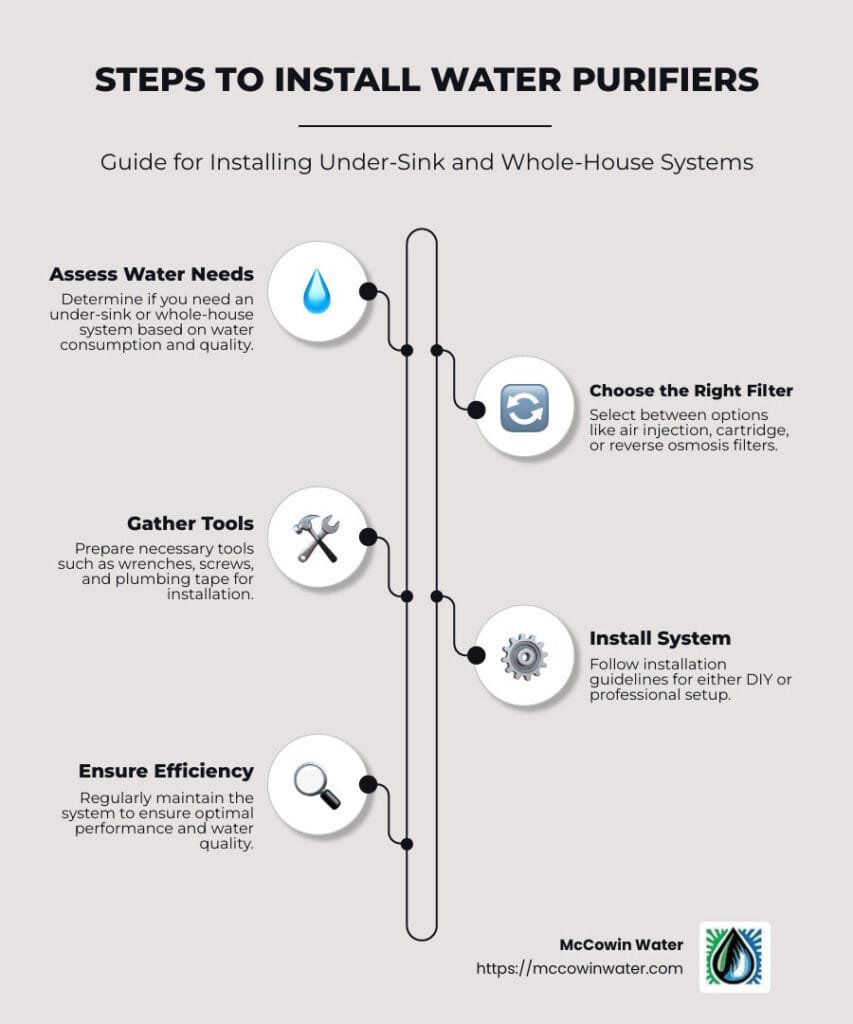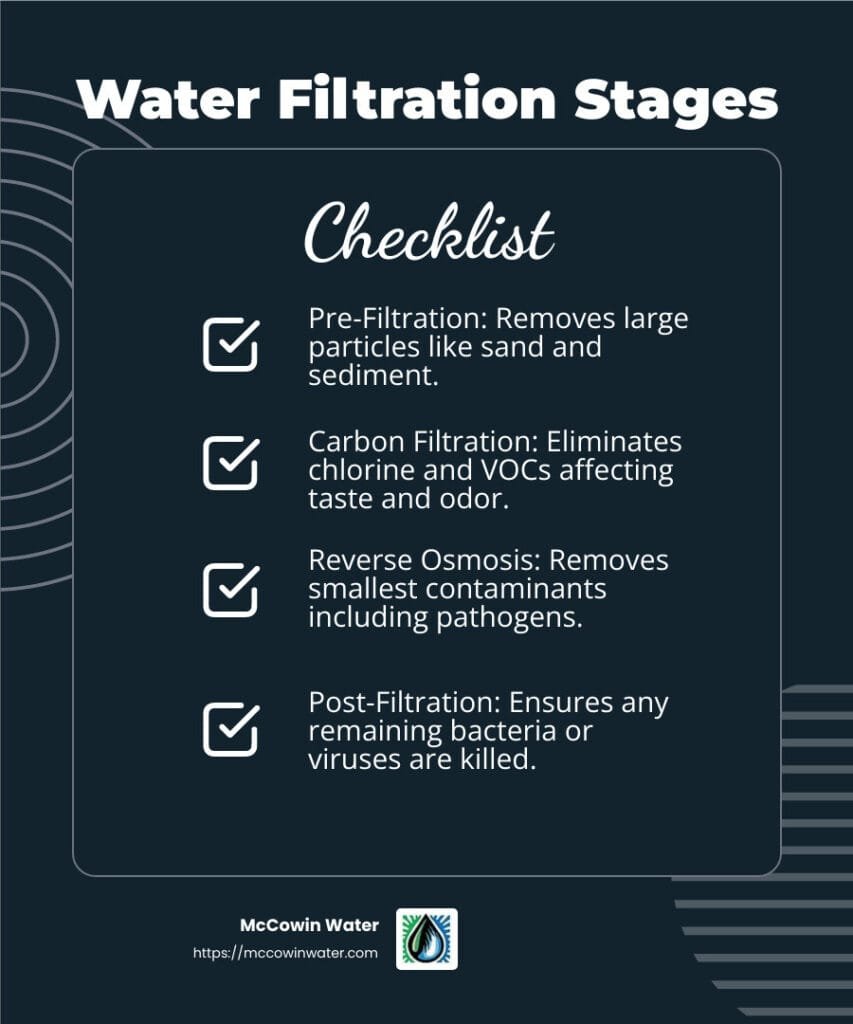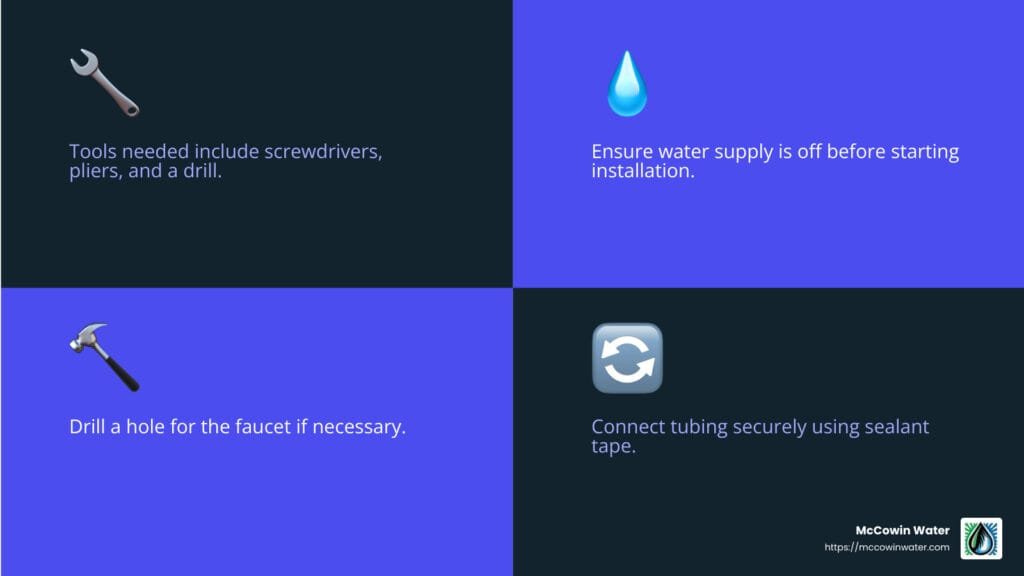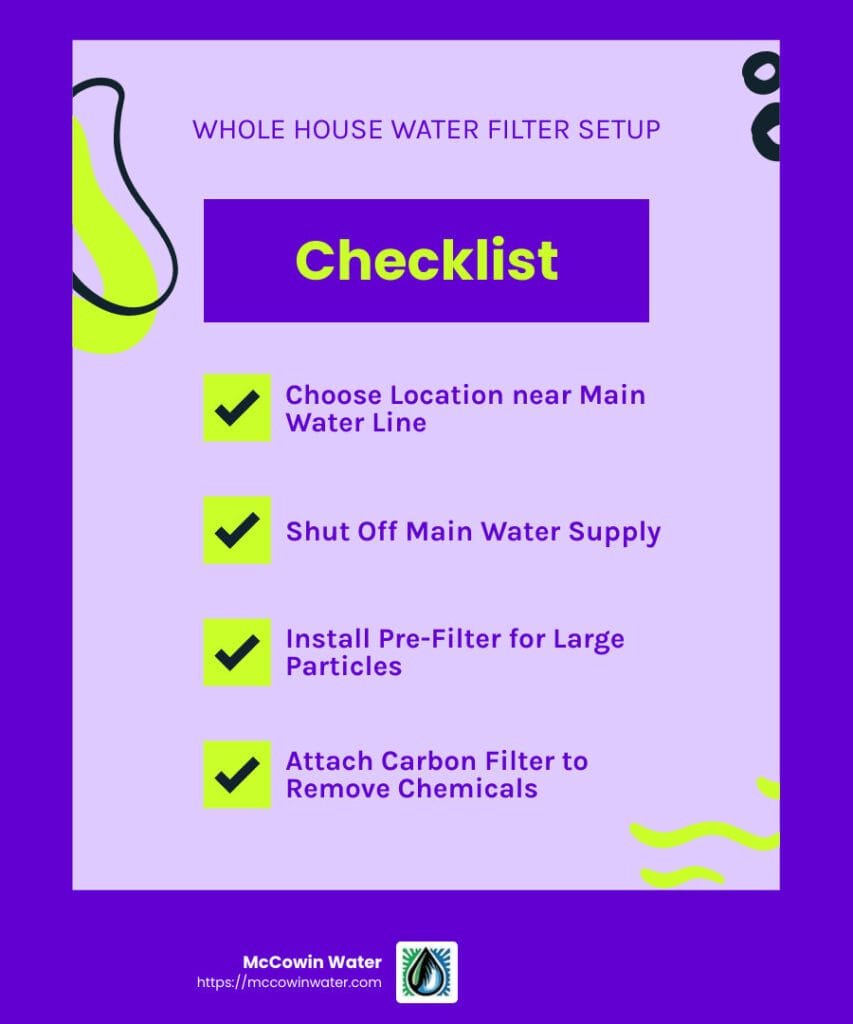Installing water purifier solutions are on the minds of many homeowners seeking cleaner, safer, and more sustainable water solutions. We’ll explore straightforward steps to install water purifier systems and help you decide on the best options for your home, whether it’s under-sink systems for targeted purification or whole-house units for comprehensive coverage.
- Understand your water needs: Identify if you need an under-sink or whole-house system depending on your household’s water consumption and quality issues.
- Choose the right filter: Consider air injection, cartridge, or reverse osmosis filters based on contaminants present in your water.
- Follow installation guidelines: Ensure proper setup by either DIY or professional installation to maintain system efficiency and water quality.
Water filtration at home is essential for safeguarding your family’s health and optimizing the lifespan of your appliances. This guide is intended to make the transition from tap to pure water as seamless as possible. From filtering out small particulates to removing chemicals and pathogens, domestic purification systems have evolved to meet various needs with eco-friendly solutions.
I’m Brian McCowin, and with over 46 years in the water industry, I’m here to simplify your journey towards cleaner water. Born into the business, I’ve dedicated my life to understanding the intricacies of water filtration. My mission is to help you install water purifier systems efficiently and ethically.

Understanding Water Purification Systems
Water purification systems are essential for ensuring that the water in your home is clean and safe to drink. They work by removing contaminants and impurities through various stages of filtration. Let’s break down the types of filters, the stages of filtration, and the contaminants these systems target.
Types of Filters
Different water filtration systems use different types of filters, each designed to tackle specific impurities:
- Air Injection Filters: These are great for treating hard water, especially if it contains metals like iron and manganese. They use air to oxidize and precipitate these contaminants.
- Cartridge Filters: Widely used in household systems, these filters remove suspended particles and sediments. Some even use carbon to eliminate pesticides and chlorine. These need regular replacement.
- Reverse Osmosis (RO) Systems: These systems use multiple stages of filtration, including a semi-permeable membrane to remove a wide range of contaminants, from bacteria to heavy metals.
- Microfilters, Ultrafilters, and Nanofilters: These advanced filters can remove bacteria, viruses, and even chemicals without the use of additional chemicals.
Filtration Stages
Water purification typically involves several stages, each designed to remove different types of impurities:
- Pre-Filtration: Large particles like sand and sediment are filtered out. This is often done with screen or bag filters.
- Carbon Filtration: This stage removes chlorine, volatile organic compounds (VOCs), and other chemicals that affect taste and odor.
- Reverse Osmosis or Advanced Filtration: At this stage, the smallest contaminants, including dissolved solids and pathogens, are removed.
- Post-Filtration: Sometimes, additional filters like UV or ozonation are used to ensure any remaining bacteria or viruses are killed.
Common Contaminants
Knowing what contaminants are in your water will help you choose the right system:
- Metals: Iron and manganese are common in well water and can be removed with air injection filters.
- Chlorine and Pesticides: Often found in municipal water, these can be effectively reduced with carbon filters.
- Bacteria and Viruses: Reverse osmosis and nanofiltration systems are excellent for removing these pathogens.
- Sediment and Particulates: Easily removed with pre-filtration systems like cartridge or bag filters.

Each of these filters and stages plays a crucial role in producing clean, safe, and great-tasting water for your home. By understanding your water’s specific needs, you can choose a system that provides the best protection against contaminants.
How to Install Water Purifiers
Installing a water purifier can seem daunting, but with the right guidance, it can be a straightforward DIY project. Whether you’re setting up an under-sink system or a whole house filter, understanding the process and having the right tools is key. Let’s explore the specifics of installing these systems.
Installing Under-Sink Water Purifiers
Most under-sink water purifiers are a popular choice for targeting specific points of use, like kitchen sinks. They save space and are more cost-effective than whole-house systems. Here’s how to get started:
Tools Needed:
- Slotted and Phillips screwdrivers
- Pliers and adjustable jaw wrench
- Tubing or box cutter
- Electric drill with a 1-1/4” drill bit (if no existing hole for the faucet)
- Sealant tape, such as Teflon® tape
Installation Steps:
- Shut Off Water Supply: Before you begin, ensure your water supply is turned off to avoid any “water-under-pressure” surprises.
- Install Fitting: Attach a fitting to the cold water supply line under your sink. This is where the system will connect.
- Create Faucet Hole: If your sink doesn’t have an existing hole, use the drill to create one for the filtered water faucet. You can also replace a soap dispenser or sprayer hole.
- Install Faucet: Secure the decorative faucet included in your system into the hole.
- Connect Tubing: Attach the tubing from the water filter system to the fitting and the new faucet. Use sealant tape to ensure a tight seal.
- Secure the System: Mount the filtration unit under the sink, ensuring it’s easily accessible for future filter replacements.

Under-sink systems often include cartridge filters or reverse osmosis units, which are excellent for removing a wide range of contaminants.
Installing Whole House Water Filters
If you’re looking to improve the water quality throughout your entire home, a whole house system is the way to go. These systems filter water as it enters your home, providing clean water at every tap.
Tools Needed:
- Slotted and Phillips screwdrivers
- Pliers and adjustable jaw wrench
- Tubing cutter
- Propane torch and soldering kit (for copper pipes)
- Sealant tape
Installation Steps:
- Choose Location: Select a spot near the main water supply line where the system will be easily accessible for maintenance.
- Shut Off Main Water Supply: As with under-sink systems, ensure the main water supply is turned off.
- Cut the Pipe: Use the tubing cutter to cut into the main water line where the filter will be installed.
- Install Pre-Filter: If your system includes a pre-filter, attach it to remove large particles and sediment before the water reaches the main filter.
- Attach Carbon Filter: Connect a carbon filter to remove chlorine and other chemicals that affect taste and odor.
- Solder Connections: For copper pipes, clean and deburr the lines, apply flux, and solder the connections. Make sure to use sealant tape on threaded fittings.
- Install Shut-Off Valves: Add ball valves on either side of the system for easy maintenance and filter changes.
- Grounding: If you have metal pipes, ensure they remain grounded by installing grounding clamps and a jumper cable around the filter.
Whole house systems are ideal for homes with multiple bathrooms and kitchens, providing comprehensive filtration with pre-filters and carbon filters.

By following these steps, you can effectively install water purifiers that best suit your household needs, ensuring clean and safe water for your family. Now that we’ve covered installation, let’s explore the benefits of having these systems in your home.
Benefits of Installing Water Purifiers
Protect Pipes
Installing a water purifier can significantly protect your pipes from the damaging effects of hard water and sediments. Hard water is notorious for causing scale buildup in plumbing, which can lead to clogs and reduce water flow. Over time, this buildup can cause pipes to corrode and even burst. By using a water purifier, you can filter out these minerals and sediments, extending the life of your plumbing system and saving on costly repairs.
Improve Taste
One of the most noticeable benefits of a water purifier is the improvement in water taste. California residents are the last in line to get our water from The Rockies. Although they do their best, municipal water (even after treatment), can sometimes taste or smell unpleasant due to chlorine and other chemicals used in the treatment process. Carbon filters, often used in both under-sink and whole house systems, are highly effective at removing these chemicals. This results in water that not only tastes better but also smells fresh. Imagine enjoying a glass of water that’s free from any off-putting flavors or odors—it’s a simple pleasure that a good water purifier can provide.
Remove Contaminants
Water purifiers are essential for removing contaminants that may not be caught by municipal treatment plants or that are present in well water. These contaminants can include nitrates, arsenic, bacteria, and volatile organic compounds, which can pose health risks if consumed over time. Different filtration systems, such as reverse osmosis or ion exchange, target specific impurities, ensuring your family has access to safe drinking water. This is especially crucial for households with private wells, where water quality can vary significantly.
By investing in a reliable water purification system, you not only safeguard your family’s health but also improve the overall quality of your home’s water supply. This simple addition can make a world of difference in your daily life, from cooking to bathing.
Next, we’ll dive into some frequently asked questions about installing water purifiers, addressing common concerns and helping you make informed decisions.
Frequently Asked Questions about Installing Water Purifiers
How much does it cost to install a water purification system?
The cost of installing a water purification system can vary greatly depending on the type of system you choose. Under-sink systems, which are ideal for individual sinks, are generally more affordable. They typically range from $1,200 to $5,000, depending on the complexity and brand. These systems are a great choice if you’re looking to improve water quality in specific areas, like the kitchen.
On the other hand, whole-house systems are a more significant investment, usually costing between $5,000 and $50,000+. These systems filter water for the entire home, providing comprehensive protection against contaminants. While they are more expensive upfront, they can be more cost-effective in the long run, especially if you have multiple water outlets to consider.
Professional installation can add to these costs. However, if you have some DIY skills, you might save on labor by installing the system yourself.
Can I install a water purifier myself?
Yes, many people choose to install water purifiers themselves, especially under-sink systems. These systems often come with detailed instructions and require only basic tools like screwdrivers, pliers, and an adjustable wrench. If you’re comfortable with simple plumbing tasks, you can likely handle this project.
For those considering a whole-house system, the installation is more complex. It involves connecting the system to the main water supply. While it’s possible to do it yourself, it’s often recommended to hire a professional to ensure the system is installed correctly and safely.
If you’re unsure about any step, don’t hesitate to consult a professional. It’s better to be safe and ensure your system is functioning properly.
Are water purifiers worth it?
Absolutely! Installing a water purifier can offer numerous benefits that make it a worthwhile investment.
Plumbing Protection: By filtering out minerals and sediments, water purifiers help prevent scale buildup in your pipes, reducing the risk of clogs and corrosion. This can extend the life of your plumbing system and avoid expensive repairs.
Appliance Longevity: Clean water is not just better for drinking; it also benefits your appliances. By removing impurities, water purifiers help keep appliances like dishwashers and washing machines running efficiently and lasting longer.
Overall, the peace of mind that comes from knowing your water is clean and safe is invaluable. Whether you’re concerned about taste, contaminants, or the health of your plumbing, a water purifier is a smart choice for any home.
Conclusion
At McCowin Water, we understand the importance of having clean, safe water for your home or business. Our custom systems are designed to meet the unique needs of each client, ensuring that you get the best solution for your water purification needs. Whether you’re looking for an under-sink system to improve water quality in your kitchen or a whole-house system to protect your entire plumbing network, we’ve got you covered.
Our commitment to exceptional service sets us apart. We pride ourselves on offering personalized customer support and guidance throughout the installation process. Our team of experts is ready to help you choose the right system and provide professional installation services, ensuring that your water purifier functions efficiently and effectively.
Choosing McCowin Water means choosing peace of mind. With our American-made, NSF-certified or WQA (Water Quality Association) products, you can trust that your water is in good hands. We’re dedicated to providing Orange County, California, with top-notch water filtration and purification solutions that keep your water clean and your family healthy.
Explore our products to find the perfect water purification system for your home or business. Let us help you make the right choice and enjoy the benefits of clean, uncontaminated water today!
Why Homeowners Should Install a Home Water Filtration System
How Do I Know If I’m Ready for a House Water Filter System?
Water Purification Systems: The Hidden Health Risk Lurking in Orange County’s Most Luxurious Homes
A Filtration Water System for Home Should Have These 3 Things
How to Choose the Best Water Filtration System for Your Irvine, CA Home

